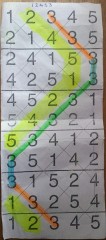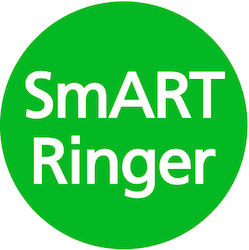 I’ve recently begun ringing Plain Hunt Doubles and when I did it was suggested I started on the third bell. The reasoning behind that was that when ringing on third the order that you ring over the other bells is 4,5,1,2,4,5,Lead,Lead,1,2 which means that you are simply ringing over the bells in order. That means there is one less thing to worry about and it helped me concentrate more on watching the other ropes and striking accurately and less on remembering bell numbers. It makes it easier to count places as well.
I’ve recently begun ringing Plain Hunt Doubles and when I did it was suggested I started on the third bell. The reasoning behind that was that when ringing on third the order that you ring over the other bells is 4,5,1,2,4,5,Lead,Lead,1,2 which means that you are simply ringing over the bells in order. That means there is one less thing to worry about and it helped me concentrate more on watching the other ropes and striking accurately and less on remembering bell numbers. It makes it easier to count places as well.
It’s a big jump from call changes – having to hold up or pull in for every stroke feels very strange at first, and when coming down to the front in particular it’s very easy to get slower and slower as you do, as you feel as if you are racing ahead of where you need to be. Coming on and off the lead is the bit I’ve found the hardest – leading accurately after ringing down to the front is hard enough, but coming off the lead is particularly tricky. It feels like you have to hold up for ever, which means that your backstroke at lead doesn’t just have to be accurate, you also really need to get the bell up for the following handstroke!
I’ve also found the free Methodology Android phone app very useful. Not only does it have a database of all the different methods (Tip: Plain Hunt is listed as “Original”), it also has a method player that plays the bells whilst showing you the striking order and blue line. It also allows you to take any of the bells and it ring by tapping on the screen at the appropriate point. You can set the ringing speed and there’s a display that shows you how accurate your striking is. It’s not a full substitute for ringing a real bell as there’s no delay between tapping and the bell striking, and you can’t really practice ropesight with it. However if you don’t cheat by looking at the screen 😉 you have no option other than to count places so it’s a good aid to learning for how to do that, as well as listening, for example hearing where the treble is.
Ropesight is going to be the next big challenge I think, I’ve started lurking behind the experienced ringers (they don’t mind, honestly!) I’m not worrying at this stage about knowing the blue line they are ringing, I’m just trying to spot which bells they are following. Some people are easier to follow than others – standing behind the ringer who is ringing one-handed with their eyes shut whilst waving the other hand around to correct everyone else in the band who has gone wrong doesn’t help much, I try to pick one of the ringers who is more like the eagle-eyed toys of my distant youth, as you can get clues by watching who they are looking at. It’s is an odd skill – I can get a run where it’s really obvious which bell is being followed and then I lose track and don’t seem to be able to get ‘back in’ again for a bit, but having said that it is getting gradually easier.
I’ve also found ringing cover for Plain Bob Doubles helps – rather than trying to learn the exact order of bells to follow I’m trying to remember the general pattern and to fit the bells to that – back,hand over three different bells, then back,hand,back,hand over another, then back,hand over another three bells and so on. And because you are always in the same place (you hope!) even if you can’t spot who is in front of you, if you just keep your nerve and ring steadily you’ll be able to bluff your way through until you pick it up again. And even better if you can persuade the person who rings with their eyes shut to stand behind you with their eyes open, calling out the bell to follow when you come adrift 🙂


Well done!
Nice to see someone doing all the right things and learning..
Ropesight is not an easy technique (is any of it?) but tenoring behind does help…
Thanks Graham, although I can’t take all the credit – I have good teachers, the informal ones as well as the formal one 🙂 And I forgot to mention the other challenge – ringing up and down in peal, which currently makes plain hunt seem like a walk in the park…
Hi Alan,
We love reading your updates – sounds like you’re doing really well – and good idea to take inspiration from that ‘eagle eyed’ action man (with or without the aid of a parachute!)
My childhood toys weren’t nearly as full as useful tips for developing ropesight or other ringing techniques.
https://www.youtube.com/watch?v=JlbW6Qp7lyo
Where was ‘Bob doubles Barbie’ when I needed her? 🙂
Thanks Rose, I’m really enjoying the challenges, and every step forward reveals a whole set of new ones! I’m also trying to get ahead of the game by learning Plain Bob Doubles on the Methodology app, and I’ve just figured out that a bob call in PBD rotates the middle three bells around, so 2 takes over ringing 3’s blue line, 3 takes 4′ s and 4 takes 2’s which, to me at least, makes more sense than some of the explanations I’ve read about “running out” etc! Now all I have to do is get to the point where I can actually *ring* it 🙂
And I’ll be keeping an eagle eye out for Stedman Sindy 🙂